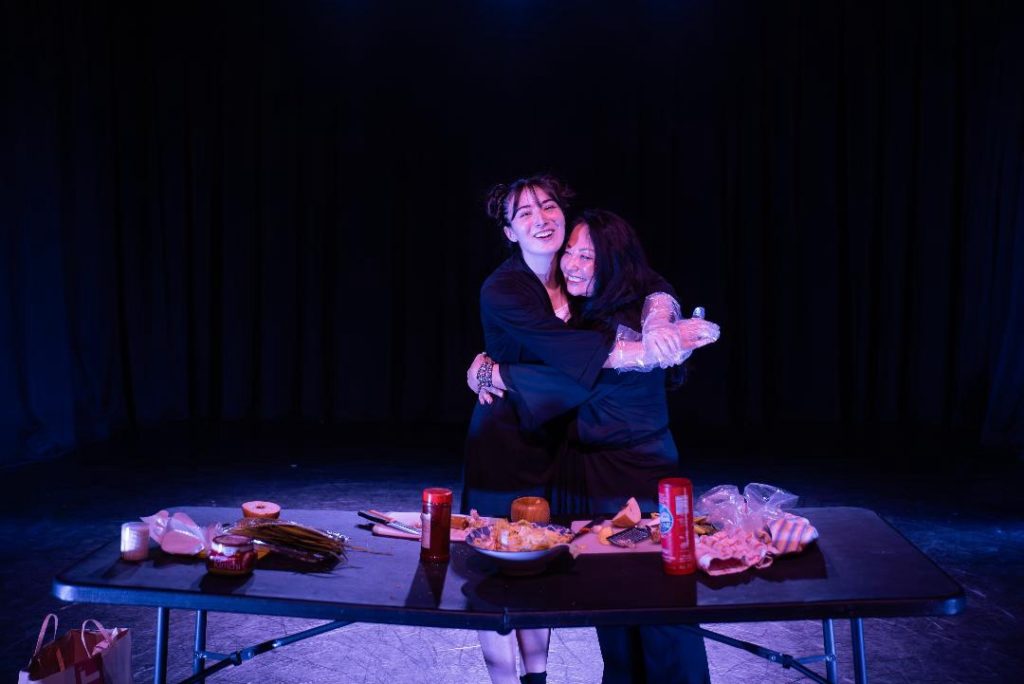Words by Natalie Albaran.
Sunhi Willa Keller and her mother greeted incoming audience members with a pre-show tutorial on how to make kimchi. Behind a black table littered with garlic, gochugaru, cabbage and other kimchi ingredients, they talked through the process and told family stories. They flowed with cooking show-esque charisma and a familial quality reminiscent of matriarchal gossiping and home-making.
Arts on Site hosted four showings of Sunhi Willa Keller’s Kaja! and 9 Tales of a Bitch between July 26 and July 27, 2024. Keller is a NYU and London Contemporary Dance School alum, whose work has been performed at venues and festivals all over New York City.
Kaja! which starred Keller, Amanda Knight, Makenna Hosobuchi-Wolff, and Aishia Lin, retold a famous Korean folktale, “Chong Kaeguri,” with Keller’s own twist. The movement oscillated between graceful runs and sharp, almost abrasive motion, to a backing track of rice being washed and then cooked.
The four dancers then disappeared behind the curtain upstage, seemingly done with their performance. For a moment, my anxiety started to rise, as I didn’t fully understand what was going on. But then my anxiety quickly dissipated as it was replaced by laughter.
The curtains, partly open, illuminated a frantic cast in flashes, ostensibly looking for their costumes. A voice behind the curtain, referring to a traditional rice hat we glimpsed as the curtains swooshed, went, “I don’t wanna wear that hat. It’s too stereotypical.”
Out strutted our cast of four. One adorned in pink heart sunglasses and pink rubber gloves: the narrator. Another in a frog headband, and another in a crocheted hat and swim goggles: the kids. A fourth, in a safari hat: the mother of said frogs.
The narrator then told the story. Two kid frogs do the opposite of what their mother tells them to do. Stay still? They’d jump as high as they could. In a fun twist that digs at gender stereotypes, Keller’s story diverges from the original: find a man and settle down? The frogs would rather not. The mother tries to get them to listen to her, all her life, to no avail. As she gets old and sick, things didn’t change.
Finally, on her deathbed, resigned to the reality that her children will always do the opposite of what she tells them, she tells them to bury her in the river. She thinks they’ll bury her in the mountains as she truly wishes. Overtaken by grief when she finally passes, her children, determined to honor her wishes for the first time, bury her by the river, only for her body to wash away when the rain comes.
As tragic as the story is, the dance held grief and laughter in the same breath, “I’m sick of that ending!” the frog in the goggles yells at the narrator. The autonomy that the characters had in comparison to the original story was refreshing. It graciously recognised the wisdom that newer generations also have the power to change a story if we so choose.

Cut to black.
The brief intermission was cut off by the giggles of a women in pink behind two magenta jeopsons (traditional hand-held Korean fans), beginning 9 Tales of a Bitch: a reimagination of Kumiho, a nine-tailed fox from Korean mythology that often transforms into a beautiful woman who seduces men, only to eat their souls. It starred Keller, Knight, and Julia Foti. All three held fans covering the majority of their faces, giggling, and making the occasional remark: “I can’t believe you’d say that! Oh my God, she’s such a bitch, I know.”
The visage of demure, hyper-feminine figures was completed with the visual aesthetic of a traditional Korean fan dance. The music was meditative, and the image of the “bitch” that the performers whisper and laugh about simultaneously becomes more tangible and mythological.
The graceful and flowy movement of the fan dance decayed into a more sensual mess of hair and limbs as the dancers tumbled on the floor together, and the giggles turned to sound like cries. They seemed tired of tearing down other women– of being restricted to the box of societally- expected femininity. They represented this facade of laughter and power over what really is pain and disempowerment.
The final image the audience sat with was wild hair flips and the gasps of air. It drove home the feelings of those facing the glass ceiling: a fighting, persevering, yet tired spirit.
What resonated with me in both of these pieces was the idea of reclamation. Claiming full personhood even when others– be it tradition, internalised misogyny, shame, etc.– try to take it away. Instead, Keller chose to take back a story and make it hers.
